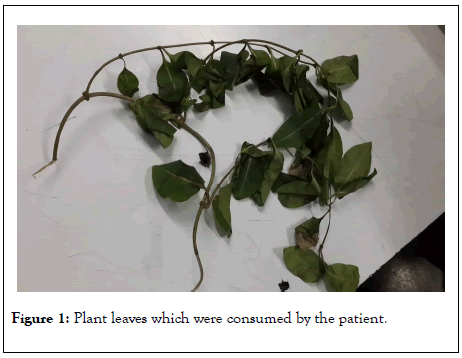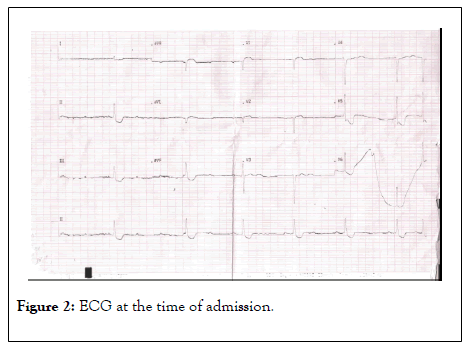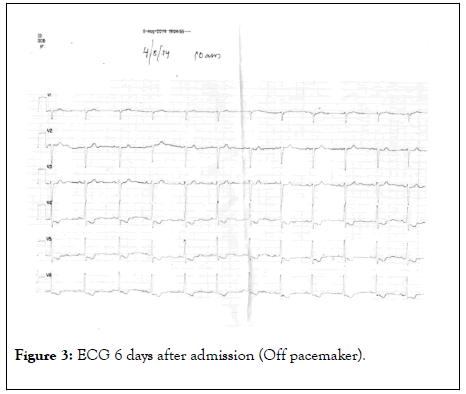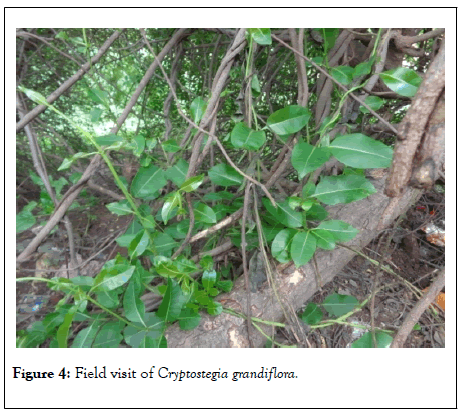
Journal of Clinical Toxicology
Open Access
ISSN: 2161-0495

ISSN: 2161-0495
Case Report - (2020)Volume 10, Issue 2
Cardiac glycosides are found in various plant products. Here we report a case of poisoning due to Cryptostegia grandiflora which was prescribed for a particular skin disease by a herbal medicine practitioner. This patient presented with nausea and was found to have second degree AV block. It was initially suspected to be a case of yellow oleander poisoning which is common in the southern part of our country, but was later found to be poisoning due to Cryptostegia grandiflora which also contains cardiac glycosides. A field visit and examination of the plant by a botanist confirmed the same. The patient required temporary pacing for the arrhythmia and was discharged after a week.
Cryptostegia grandiflora; AV block; Arrhythmia; Hyperkalemia; Thrombocytopenia.
In the emergency department, the combination of gastrointestinal symptoms with heart block should make one suspect poisoning due to cardiac glycosides. Here we report a case of poisoning due to Cryptostegia grandiflora which also contains cardiac glycosides. Toxicity of Cryptostegia grandiflora is known among animals. However, very few case reports are available on the human toxicity of Cryptostegia grandiflora worldwide.
A 45-year-old male presented to the emergency department with recurrent episodes of vomiting of one day duration. He had ingested a paste made up of leaves of a plant, which was given to him by a herbal medical practitioner as a treatment for his chronic skin condition. Leaves eaten by the patient are shown in Figure 1. On evaluation, he was conscious and oriented. His pulse was 48 per minute. The blood pressure was 100/70 mmHg. He had multiple scaly plaques all over the body suggestive of psoriasis. Examination of the heart, lungs and abdomen were normal. Neurological examination was also normal.

Figure 1: Plant leaves which were consumed by the patient.
ECG showed second degree AV block. He required temporary pacing for the same. He was also given symptomatic treatment. The patient remained stable after temporary pacing. On day 3 of admission, pacemaker was put off and patient had normal sinus rhythm. ECG at the time of admission and after 6 days of admission are shown in Figures 2 and 3 respectively.

Figure 2: ECG at the time of admission.

Figure 3: ECG 6 days after admission (Off pacemaker).
Initial laboratory investigations revealed potassium of greater than 6 meq/L with normal sodium levels. Patient also had mild renal dysfunction with a creatinine of 1.4 mg/dl and urea of 64 mg/dl. He was non-oliguric.
He was treated with insulin with dextrose, beta-2 agonist (salbutamol) and calcium gluconate. Potassium levels had decreased to 4 meq/L on day 4. He did not require hemodialysis for hyperkalemia. Patient also had mild thrombocytopenia 87000 /mm3 which improved to 1,20,000 /mm3 by day 6. He had no bleeding manifestations.
His CK levels were 1039 IU/L at presentation which had decreased to 475 IU/L on day 3 of admission.
This was initially managed as a case of yellow oleander poisoning. He was asked to procure the leaves of the plant which were different from that of yellow oleander. Later, field visit confirmed that the leaves were of the plant Cryptostegia grandiflora. He improved and was discharged from the hospital after a week. Field visit of Cryptostegia grandiflora is shown in Figure 4.

Figure 4: Field visit of Cryptostegia grandiflora.
In India there is widespread use of plant parts for treatment by practitioners of various systems of medicine. These include the Siddha system of medicine prevalent in South India, principally in the state of Tamil Nadu and the Ayurveda system widely prevalent all over India. Cryptostegia grandiflora also known as the rubber vine is a native plant of Madagascar but is also distributed throughout the tropics [1]. This plant is used in alternative medicine as it is found to have antiproliferative, antioxidant, and antidiabetic properties [2]. It is used in the Siddha system of medicine for the treatment of eczema and also as an anti-fungal. Other uses are as purgative, analgesic and for treatment of schistosomiasis [3]. Root extracts are given as antidote in snake bite. It is known by various names such as Vilayti-vakundi (Marathi), Garudappalai, Kauli (Marathi), Rubber vine, Chabukchhuree, Purple allamanda, Palay Rubbervine, Rubber ki bel (Hindi). In tamil it is known as Palai [4]. This plant contains cardiac glycosides and is toxic to horse, sheep and goat. Human toxicity is also reported but very few case reports are available worldwide.
The clinical features seen in horses after consumption of leaves were colic, dyspnea, profuse sweating, muscle twitching, weakness and cardiac arrhythmias. Necropsy findings include epicardial and endocardial hemorrhage, and congestive cardiac failure. Subcapsular hemorrhages in spleen, liver and hyperemia of gastric and intestinal mucosa were also seen [1].
In humans it is known to produce the following symptoms:
a. GI symptoms -abdominal pain, nausea, vomiting, anorexia.
b. Cardiac - cardiac arrhythmias (Mobitz type 1, Mobitz type 2, junctional rhythm, AV dissociation, atrial fibrillation). Life threatening arrhythmias are known with Cryptostegia poisoning. Death due to ventricular tachycardia is also documented. Other arrhythmias reported are Mobitz type 1, Mobitz type 2, junctional rhythm, AV dissociation and atrial fibrillation [3].
c. Neurological -hypertonia, hyperreflexia, subtle higher mental function derangement, weakness, lethargy and delirium [3].
d. Hematologic -bleeding manifestations due to thrombocytopenia. There is evidence of the presence of thrombin and plasmin-like activities in Cryptostegia which contribute to the procoagulant and fibrinogenolytic activity [4,5]. Epistaxis due to thrombocytopenia requiring platelet transfusions is also reported in literature [1].
Elevations of CK total also has also been reported [3]. Patients can also present with circulatory collapse. Hyperkalemia is another life threatening manifestation of Cryptostegia poisoning. The mechanism behind cardiac glycosides causing hyperkalemia is inhibition of Na+-K+ ATPase which results in increase in extracellular potassium.
The poisoning due to Cryptostegia grandiflora mimics digitalis toxicity [6]. Digoxin levels were found to be high in patients who had consumed Crypotstegia grandiflora [7].
Our patient had gastrointestinal symptoms, cardiac arrhythmia, thrombocytopenia, hyperkalemia and elevation of CK total. He was treated symptomatically for his gastrointestinal symptoms. The second degree AV block required temporary pacing. He had mild thrombocytopenia with no clinical manifestations. He also required anti-hyperkalemic treatment. He did not require dialysis. The CK total elevation showed a decreasing trend subsequently similar to that of a case report from Pune [3].
In patients presenting with abdominal complaints, bleeding manifestations and arrhythmias, poisoning due to Cryptostegia should be considered. The complete spectrum of manifestations of Cryptostegia grandiflora are yet to unfold are as there are very few case reports.
Citation: Nathan B (2020) A Mimicker of Yellow Oleander Poisoning. J Clin Toxicol. 10:437. DOI: 10.35248/ 2161-0495.20.10.437
Received: 01-Apr-2020 Accepted: 15-Apr-2020 Published: 22-Apr-2020 , DOI: 10.35248/2161-0495.20.10.437
Copyright: © 2020 Nathan B. This is an open-access article distributed under the terms of the Creative Commons Attribution License, which permits unrestricted use, distribution, and reproduction in any medium, provided the original author and source are credited.